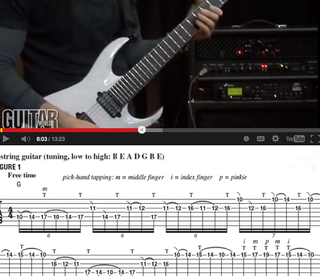Chaos Theory with Chris Broderick: Getting a Handle on Essential Pick-Hand Techniques

Hello and welcome to my new Guitar World instructional column, Chaos Theory.
- Over the next several months I’m going to show you a variety of the techniques that I consider essential to my approach to the
- electric guitar.
The exercises in this month’s column emphasize pick-hand techniques that are intrinsic to my style: sweep picking, alternate picking and multiple-finger fretboard tapping. Specifically, I wanted to create a convergence of these different playing techniques within a musical-sounding piece. All the examples demonstrated in this column are played on seven-string guitar in standard tuning (low to high, B E A D G B E).
Let’s start with bar 1 of FIGURE 1: I begin with an ascending run based on a Gmaj7 arpeggio (G B D F#). All the pick-hand-tapped notes in this bar are sounded with the middle finger (indicated by m). There is no picking in the first two bars of this figure, and some of the notes are sounded by firmly hammering the fretting finger down onto the string.
Although the run is phrased mostly as sextuplets and septuplets, it ascends in four-note patterns, with each successive four-note group starting one note higher within the arpeggio: the first four notes, G B D G, are all sounded on the fifth string, with the D at the 17th fret as the tapped note. The next four-note group is B D F# B, followed by D F# G D and then F# G B F#; the pattern then starts with the first four notes again, G B D G, but one octave higher.
In bar 2 I descend and ascend straight through the Gmaj7 arpeggio in two octaves. On beat four, I employ multiple-finger pickhand tapping to play a scale fragment on the high E string, moving from the index finger (i) to the middle-finger (m) to the pinkie (p) and back down, followed by fret-hand pull-offs. I switch to sweep picking in bar 3, descending and ascending through a C major arpeggio (C E G) in two octaves, followed in bar 4 with a primarily alternate-picked descent through the G major scale (G A B D C E F#).
The run wraps up in bars 5 and 6, starting with a tonal shift from G major to its relative minor triad, E minor. On beat one I play a quick descending and ascending Em arpeggio, followed on beat two by some legato scalar movement, with all the notes sounded on the high E string with hammer-ons and pull-offs. Beat three brings multiple-finger tapping back into play, as I roll on the high E string from index to middle to pinkie and then back down, followed by fret-hand pull-offs. The phrase ends with a three-octave descending Em arpeggio, played across beats four and five of bar 5, followed by a big, low B5 power chord.
Guitarists often ask me, “How do I develop my pick-hand tapping ability so I can execute multiple-finger tapping techniques?” The first thing is to observe your fret-hand technique and imitate it. My multiple-finger tapping technique is still developing, so if there is a pick-hand tapping figure that I’m having trouble with, I’ll play it with the fret hand first and watch the motion of the fingers. Then I’ll try to imitate those mechanics with my pick hand.
It’s good to start with something simple, like the ascending three-notes-per-string scale shown in FIGURE 2. Once you become comfortable playing scales this way, try moving on to arpeggios, as shown in FIGURE 3, which are more challenging.
This technique also lends itself well to pentatonic scales, as demonstrated in FIGURE 4. To help me move seamlessly between normal playing and multiple-finger tapping, I invented a “pick clip,” which affixes my flatpick (I use a Dunlop Sharpie) to my thumb.
This device conveniently allows my index finger to let go of the pick without dropping it so I can use all four pick-hand fingers to tap. I initially tried using thumb picks, but the design and shape never worked for me. With the pick-clip, I can use any type of pick. It would be much more difficult, if not impossible, for me to play the multiple taps in FIGURE 1 without it. I’m looking to patent it so I can make it available to others.


Get The Pick Newsletter
All the latest guitar news, interviews, lessons, reviews, deals and more, direct to your inbox!

Want to play Master of Puppets the right way? Here's how to get faster at downpicking so you can chug like James Hetfield

“A few poorly intonated sustained bends in a solo can make the guitar's most emotive technique sound bad”: Learning how to bend strings correctly is one of the quickest ways to make your playing sound better

